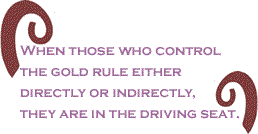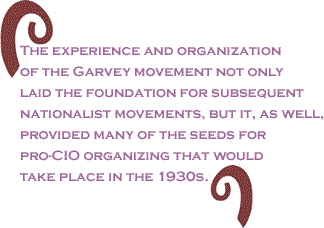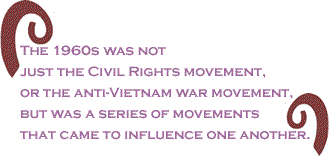| |
|

|
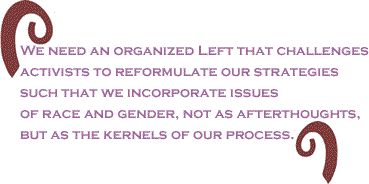
Mr.
Fletcher is President of the TransAfrica
Forum, and a longtime activist in the labor movement.
He gave the following speech at the 25th Anniversary Conference
of Labor
Notes, in Detroit, September 12. The conference slogan
was “Troublemaking in Troubled Times.”
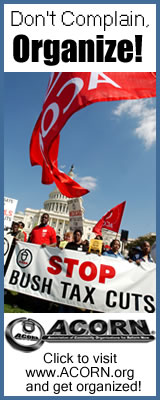 My
hope is to present some lessons from an earlier period in US
history, the 1920s
and early 1930s in particular, when the working class was facing
most difficult challenges. These are questions many of us have
been grappling with for years. I became radicalized in high school
and entered the labor movement after college, some 25 years ago.
At that point too many of us all too often glamorized and
romanticized the past rather than truly understood it. The implicit
question in looking at the period of the 1920s and early 1930s
is this: how was trade union organization able to survive? How
was it that in the 1920s the death of organized labor was regularly
predicted, but several years later there was nothing short of
a labor renaissance with the formation of the Congress of Industrial
Organizations (CIO) and the organizing of millions of workers?
Answering this question has great relevance to our current situation
where the working class, and organized labor in particular, exist
in nothing short of a de facto “state of siege.” My
hope is to present some lessons from an earlier period in US
history, the 1920s
and early 1930s in particular, when the working class was facing
most difficult challenges. These are questions many of us have
been grappling with for years. I became radicalized in high school
and entered the labor movement after college, some 25 years ago.
At that point too many of us all too often glamorized and
romanticized the past rather than truly understood it. The implicit
question in looking at the period of the 1920s and early 1930s
is this: how was trade union organization able to survive? How
was it that in the 1920s the death of organized labor was regularly
predicted, but several years later there was nothing short of
a labor renaissance with the formation of the Congress of Industrial
Organizations (CIO) and the organizing of millions of workers?
Answering this question has great relevance to our current situation
where the working class, and organized labor in particular, exist
in nothing short of a de facto “state of siege.”
Consider, for a moment,
some of the features of the 1920s. This was the era of what was
referenced as “welfare capitalism.” Unions appeared to be demonstrating
themselves to be useless to workers as capitalists advanced various
paternalistic schemes.
Labor peace was the watchword.
Employee-involvement programs and organizations were created in order
to give workers a sense of involvement in the system. By 1929, David
Brody reports, industrial disputes involved less than 1/6 the number
of workers involved in 1916, and 1/17 the number of those involved
in the peak year of 1919. In the 1920s, and contrary to popular wisdom,
there was a demonstrable trend of children breaking with their parents
and ceasing to identify with the working class in general, and trade
unions in particular. Workers were moving further and further from
their places of employment. I reference this because we act as if
this is a new phenomenon. It has been in the makings for nearly a
century.
The 1920s was a period
of severe political repression. The infamous Palmer Raids of 1919
led to the jailing and deporting of thousands of anarchists, socialists,
communists and other leftists. Much like the activities of Attorney
General Ashcroft and the crackdown on alleged terrorists, anyone
on the political Left was in jeopardy of imprisonment, irrespective
of cause or evidence, with the soon to be incarcerated being led
through the streets of Boston like Gallic prisoners following Caesar's
chariots. The Garvey Movement, the largest that Black America has
ever seen which aimed at Black awareness and a return to Africa,
was repressed, eventually leading to the jailing and deportation
of Garvey himself. The Industrial Workers of the World, otherwise
known as the Wobblies, weakened during World War I due to a massive
government crackdown and the arrest of its key leaders resulting
from their anti-war stand, was essentially finished off in the early
1920s.
In a phrase, the 1920s
represented a period of an offensive of capital. This offensive took
various forms, but two important lessons we have to keep in mind
is that when capital occupies state power it, by definition, has
the advantage. In other words, when those who control the gold rule
either directly or indirectly, they are in the driving seat. We are
always playing catch up, but this does not mean that we cannot win.
We can have no illusions about the situation, however. The so-called "Open
Shop Offensive" during the 1920s was aimed at making that point
to the working class.
The second lesson is one
that is much more difficult for progressive activists to accept.
Most workers, and most people for that matter, want social peace.
They desire quiet and stability. They are not looking for upsurges,
even though an upsurge might alleviate the pain that they feel on
a daily basis. Capital offers the illusion of labor/management peace
to the worker, at least peace on their terms. This can take the form
of the illusion of upward mobility or the myth of rugged individualism.
In the 1920s through various schemes associated with welfare capitalism,
capital seemed to offer – much as it did in the 1980s and 1990s – a
place in the sun for individual workers, at the same time that they
were crushing workers and their organizations. The notion of a partnership
with capital, and I mean that in a strategic sense rather than a
tactical sense as is often found in collective bargaining agreements,
is seductive. The 1920s demonstrated that this appeal had a resonance
among many workers, particularly those that were fortunate enough
to be employed by larger corporations. But it was not only them.
The problem that was faced at that time, and which we continue to
face, is equally illustrated by the fear many workers have of tax
increases on the wealthy, i.e., yes, these are the wealthy
today, but…hold on…I might be wealthy tomorrow! Any illusion,
accepted by workers, can become a material obstacle to the development
of class consciousness and the blocking of forward motion.
In such an inhospitable
world, what could be done? What was done?
Contrary to the wishes
of the capitalists, the 1920s was a period of great turbulence. The
problem, from the standpoint of progressives, is that this turbulence
did not ignite into a mass conflagration. Take, for instance, the
Garvey movement. The Universal Negro Improvement Association organized
millions of African Americans as well as West Indian immigrants.
Yet, the Garvey movement was not, primarily, a confrontational movement.
Garvey hoped that he could achieve some sort of detente with white
supremacy resulting in the peaceful exodus of African Americans from
the USA, returning to Africa. This did not happen, but the experience
and organization of the Garvey movement not only laid the foundation
for subsequent nationalist movements, but it, as well, provided many
of the seeds for pro-CIO organizing that would take place in the
1930s. Some explicitly Black worker organizing did take place in
the 1920s and early 1930s through A. Philip Randolph's Brotherhood
of Sleeping Car Porters and through the American Negro Labor Congress,
organized at the initiative of the Communist Party.
Organizing took place in
the Southwest, particularly among miners. This included the work
of IWW affiliates or influenced groups, but it also included work
by independent Mexican and Chicano labor unions, in some cases affiliated
with labor bodies in Mexico itself. The American Federation of Labor,
of course, regularly ignored such workers as un-organizable.
In Hawaii, significant organizing took place led, originally, by the Japanese
Federation of Labor and the Filipino Federation of Labor, ethnic-based organizations
within Hawaii itself. By 1920 both groups decided that organizing on ethnic
lines was problematic and moved to merge into the Hawaii Labor Association.
On the
mainland, real possibilities for a breakthrough
by progressives took place when long-time radical
trade unionist and later Communist
Party leader William Z. Foster helped
form the Trade Union Educational League.
What was particularly interesting about the TUEL
was that it was not a separate union or union federation. Though
it had chapters, it was more of a network, at least as we use the term
today. In some respects similar to Labor Notes and a group out of the
1980s called the National Rank & File Against Concessions, this organization
brought together activists from various AFL unions who were committed
to transforming the union movement. It had an explicit program for the
renewal of the trade union movement and, for a while, had substantial
ties not only within the left wing of labor but as well among more middle
or Center forces. Foster's notion of a "militant minority, " at
least originally, was not a sectarian
notion, but included the possibility
for a relationship between the Left
and the Center. Unfortunately, for
progressives, due to sectarianism on
the part of the Communist Party,
and an unrealistic assessment of the
period, the TUEL isolated itself and
lost its effectiveness.
The TUEL underestimated
the need for united fronts; overestimated the political consciousness
of most AFL workers; underestimated the resiliency of the AFL
leaders, regardless of their being decrepit; and, much like
many of us to this day, the TUEL failed to acknowledge that
reactionary union leaders do have a social base within
the memberships of their unions (that is, these leaders are
not floating on the surface without some ties to the base).
While it is true that the right wing of the AFL did everything
that they could to destroy the TUEL and the Left, the TUEL
made that job easier through its poor tactics and often misguided
strategy. Thus, the late 1920s decision by the CP to essentially
abandon work within the AFL in favor of the creation of its
own federation, the Trade Union Unity League, was both the
logical extension of this sectarianism, but as well the result
of active purges by the AFL bureaucracy. Let me hasten to add,
that separate and apart from the national efforts, such as
the TUEL, there were in this pre-CIO period, locally based
initiatives, particularly in the period from 1932-1935. Staughton
Lynd calls them forms of alternative unionism, and while I
do not necessarily agree with Lynd on his conclusions about
the role of these formations, I think that it is critical that
we keep in mind that there were a myriad of forms of organization
that were taking place in the fight to save trade unionism
from oblivion.
If I had more time
I would love to have the chance to delve into this period in
far more depth. This evening that will not work, so in the interest
of time I would like to suggest to you some concrete lessons
from the pre-CIO period that we should reflect upon when doing
our work in the struggle against capital and reactionary politicians:
-
Social
movements are not willed into existence: This is critically
important for us to keep in mind. As I mentioned earlier,
most people are looking for security and stability. It takes
a number of different factors to influence a social eruption. Social
movements, at the scale of what we saw in the 1890s with
the Populists and labor movements, 1930s, 1960s/early 1970s,
tend to result from the coming together of different influences
and different movements. The 1960s was not just the Civil
Rights movement, or the anti-Vietnam war movement, but was
a series of movements that came to influence one another.
It is much like the igniting of an atomic bomb. There has
to be critical mass in order for the explosion to take place.
That critical mass, when it comes to social movements, may
be struggles taking place in different sectors that come
to influence one another. Organizing in one sector demonstrates
to others that organizing, and success, is possible. Civil
Rights organizing influenced anti-war organizing, and the
women's movement, which influenced the development of rank & file
reform movements in organized labor and ultimately revolutionary
caucuses in unions.
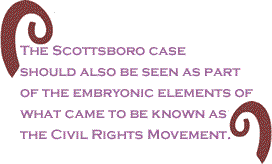
-
Mass
campaigns are critical as training grounds for activists
as well as forces for influencing public opinion: In addition
to the Garvey movement, which was not exactly a campaign,
there were two significant campaigns initiated by the Left
that helped to lay the foundation for the eruptions of the
1930s. The campaign in support of the trade union anarchists
Sacco and Vanzetti, accused of a murder during a robbery,
was a mass campaign that united Italian immigrants, trade
unionists, civil libertarians and the Left. While the campaign
was unsuccessful in preventing their execution, it was in
many respects an earth-shattering experience for those who
participated in it, and for the country as a whole. In the
early 1930s, the Scottsboro Boys case, which was led by the
Communist Party in defense of Black men accused of raping
a white woman, played a similar role. I would suggest to
you that the Scottsboro case should also be seen as part
of the embryonic elements of what came to be known as the
Civil Rights Movement.
-
Organization & Vision:
I want to make a general point here and another point at
the end of my remarks. The general point is that the pre-CIO
period was not about the good activity of individuals. Organization,
through various forms, was essential. Whether the Universal
Negro Improvement Association, the Wobblies, the TUEL, the
Hawaiian Labor Association, each such organization was not
simply a structure, but contained within itself a vision
of a different world. In 1985 I had the honor and opportunity
to interview Harry Bridges, the legendary founding leader
of the International Longshore and Warehouse Union, the split-off
from the East Coast-based International Longshoremen's Association.
My interview was 5 years prior to Bridges' passing. It became
very clear to me in listening to him, that what sustained
Bridges during the difficult times prior to the 1934 SF General
Strike that he led and which shut down San Francisco, was
a vision of what could be different, but as well feeling
part of an international movement. In some sense I think
that one can see this as grounding him at a point when virtually
everything in his environment mitigated against success.
This grounding for Bridges was in Marxism and his alignment
with the Communist Party. Other great leaders and many unknown
greats were equally grounded, albeit within any number of
groups.
- The
fight for legislation should be an integral part of our struggles,
and such victories
help to provide us with legitimacy: There has been a debate
for years about whether the passing of Section 7 of the
National Industrial Recovery Act in 1933, and later the National
Labor Relations Act in 1935 ignited a movement or were the
results of a movement. I think that the honest answer is both.
Clearly, sections of the ruling class aligned with Franklin
Roosevelt sought an arrangement with organized labor. Section
7 was part of the deal. It was also the case that the agitation
and organizing that had preceded Section 7 made its passing
and that of the NLRA, possible. But I would ask you to recall
my earlier remarks about consciousness. Section 7 and the NLRA
gave legitimacy to the workers' demands for self-organization
and collective bargaining. One need only remember that famous
FDR quote that many a CIO organizer used where the President
said: "If I were to go to work in a factory, the first
thing I would do would be to join a union." As my friend,
AFSCME Regional Director Jose La Luz reminds us, why could
we not get such a quote out of Clinton? What did it mean that
the movement could get one from FDR?
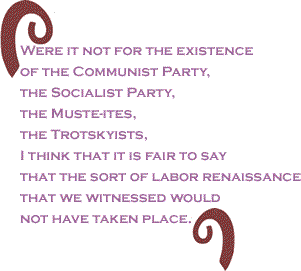
- My final point: Please
forgive me if I step on toes or if I go beyond my mandate.
It seems to me that many of us who are progressive in the labor
movement attempt to construct a strategy for renewal by drawing
selectively on lessons from the past. We discuss organizing
the unorganized, for instance, and reference the 1930s without
acknowledging that the demand or insistence on organizing the
unorganized was part of a larger demand or struggle for democracy.
The movement in the 1930s was not simply insisting that labor
needed to grow, but it connected this growth directly to the
need for a broad democratic social movement to combat fascism
and to construct a different USA. It also contained the seeds
of what came to be the early Civil Rights Movement. This is
just as true when it comes to questions of organization. Were
it not for the existence of the Communist Party, the Socialist
Party, the Muste-ites, the Trotskyists, I think that it is
fair to say that the sort of labor renaissance that we witnessed
would not have taken place. It was not just that the Left provided
the best organizers, a point that John L. Lewis was regularly
prepared to admit. It was that during the difficult times,
organization and vision kept members and supporters going.
Strategies were developed, in some cases erroneous, in other
cases brilliant, which pointed in the direction forward.
Too
many of us today act as if we need no such organization and
no such vision. We
act as if it is enough to plow away in our fields by ourselves
or with a few friends. We act as if the existence of an organized
Left, and specifically an organized Left anti-capitalist political
party is a nice idea but not particularly essential in order
to carry out our tasks. We act as if we expect that spontaneously
the dispossessed and oppressed in the USA will somehow come together
and unite for social justice, perhaps through the use of Merlin
and his magic wand! We act as if we can influence coming generations
through force of personality rather than through organization
and struggle.
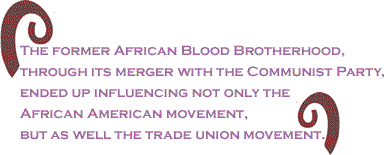
We are missing the mark.
What the organized Left brought to the pre-CIO period was not simply
trade union strategy but a connection between what was going
on in the trade union movement and what was taking place in other
movements. The former African Blood Brotherhood, through its merger
with the Communist Party, ended up influencing not only the African
American movement, but as well the trade union movement. This is
only one of countless examples.
Thus, I would suggest
to you that in learning the lessons of the pre-CIO period, let
us truly learn the lessons. Let us understand that we need more
than fighting overtime grievances; more, indeed, than organizing
the unorganized. We need a vision of a different USA, and indeed
a different world. We need an organized Left which challenges activists
to look beyond the borders of the USA and see allies, rather than
charity recipients. We need an organized Left that challenges activists
to reformulate our strategies such that we incorporate issues of
race and gender, not as afterthoughts, but as the kernels
of our process. We need, in other words, a Left-wing framework
in order to both understand the world, but more importantly, to
change it.
Labor
Notes describes itself as “the voice of union activists who
want to ‘put the movement back in the labor movement.’” The
non-profit organization also publishes a magazine of the same
name.
Click
here to contact Mr. Fletcher.
|
| |
|
|
|


